Are your company’s writers wasting time on ordinary texts when they could accomplish more important tasks?

Are you, as a journalist, tired of writing monotonous news reports or financial notes?
Are you engaged in politics but aren’t fascinated by the idea of writing public speeches?
 Just look at how harmful the life of a hard-working journalist can be. (Source: blogspot.com)
Just look at how harmful the life of a hard-working journalist can be. (Source: blogspot.com)
Due to the development of new technologies, business owners, company executives, and others responsible for writing have an opportunity to cope with these problems effectively. Today, it is possible to speed up and optimize the writing process with the help of artificial intelligence (AI).
How Can AI be Used in Content Writing?
A number of companies offer automated content generation services using proprietary AI technologies.
Automated Insights, is a company that created its own text generation platform, Wordsmith AI. This platform creates texts as if they were human-written.
Narrative Science also helps companies automate the creation of content.
In the healthcare industry, Synchrogenix provides its patented AI technologies such as Study Report Writer and Narrative Builder. These technologies are able to create clinical and non-clinical documentation, such as toxicological examination results and reports, including the results of medical research and new drug testing.
Let’s consider the process of creating text with the help of AI in more detail, using Automated Insights as an example.
How Can Kraftblick Help Your Software Company?

- We build marketing strategies from scratch and fix existing ones. More about that here.
- We provide consultations to company owners, directors, heads of marketing and sales, marketers. This is how we do it.
See you soon 🙂
Imagine that you need to write a financial report.
First, you upload data from a source or spreadsheet to the Wordsmith platform. The AI-powered program then transforms your data into variables that can be included in the future text. The platform has a flexible system of settings that allows you to customize your preferred words for text generation.
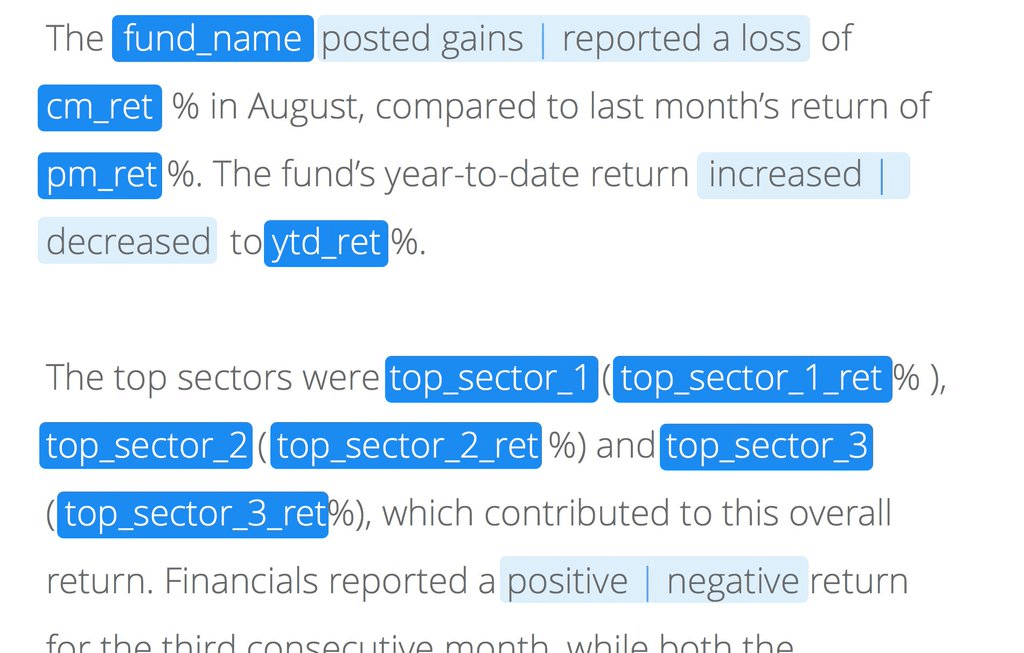 Source: twitter.com/AInsights
Source: twitter.com/AInsights
Finally, the program uses the uploaded data and the parameters that you set to generate the required text.
The AI platform learns through its work with the help of machine learning (ML). ML allows the program to evolve without any human intervention, so the software becomes more and more effective over time.
The platform can also take into account each individual customer’s profile and data, and demographic and behavioral information, to make financial reports more personalized. The customer can thus receive only the most important information on personal investments and goals.
If you want to look at how the AI program works from a different perspective, here‘s a Youtube video. In it, Larry Adams, VP of Narrative Science, tells about his company and describes in detail how its AI platform Quill generates text.
 Source: youtube.com
Source: youtube.com
What Types of Content Can Modern AI Generate?
Modern AI can now create many different types of texts:
1. Clinical reports
We’ve already mentioned Synchrogenix, a company that provides AI solutions and offers automated clinical and non-clinical documentation writing services.
Healthcare experts can use Synchrogenix technology to create clinical study reports (CSRs), which usually include detailed test results of various medications or summarize medical scientific experiments.
The creation of CSRs requires a lot of time and effort, so AI can be more effective in this kind of work than a human.
Nirpal Virdee, Director of Client Services and Technology, and an expert in Clinical Development at Synchrogenix, says,
“Without AI technology, you could spend weeks just generating the CSR draft. AI tech can generate a draft report in 24 to 48 hours. Then, the writers only have to complete the final 10 to 20 percent of effort.”
In this article, Nirpal Virdee explains how the text generation is done.
You enter data into the AI platform that will be used to create a clinical report, or enter part of a dataset (or even full clinical study reports and documents) needed to generate some brief narratives or protocols. The program will interpret the data and produce narratives or reports ready for publication.
2. Sports and financial news and reports
Modern AI technologies can generate short news reports such as financial news or summaries of the latest sports events.
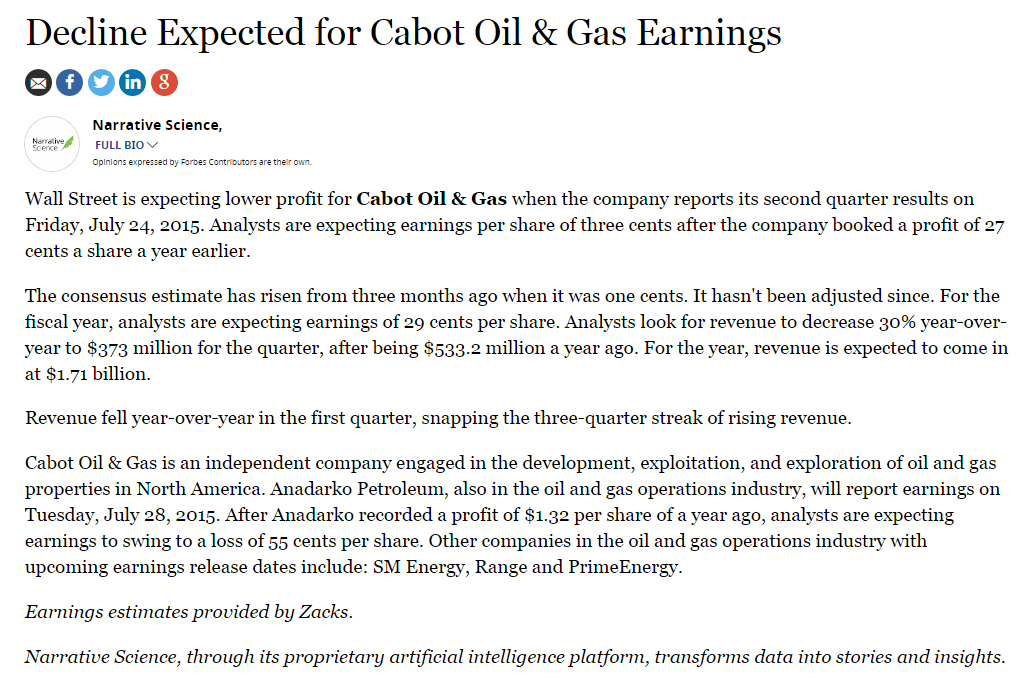 Typical financial news generated by Narrative Science for the Forbes magazine. (Source: forbes.com)
Typical financial news generated by Narrative Science for the Forbes magazine. (Source: forbes.com)
Andrew Bredenkamp, Founder and CEO at Acrolinx confirms that some companies use AI and natural language generation (NLG) technologies to automatically generate content.
For example, they might use NLG to convert financial data into text reports and turn sports scores into the narratives that form a sports column.
Yahoo uses an AI platform to produce automated fantasy football draft reports and game recaps. By doing so, Yahoo engages and monetizes its user base
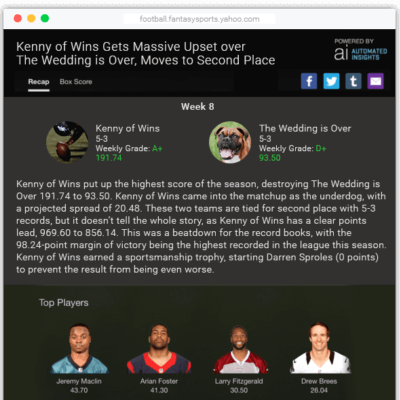 Source: automatedinsights.com
Source: automatedinsights.com
Here you will find even more examples of AI-generated financial news reports, including numerous articles that Narrative Science produced for Forbes magazine.
To see all the news generated by the Wordsmith platform, simply enter “This story was generated by Automated Insights” in the Google News search box.
The case of the Associated Press (AP) and Automated Insights is particularly noteworthy.
Their cooperation began when Associated Press started to use the Wordsmith AI platform to make stories and news reports about sports life in American colleges. Later, AP began to expand the scope of AI in its work.
Erin Madigan White, former Senior Media Relations Manager at AP, says that the Associated Press, in collaboration with Automated Insights and Zacks Investment Research, now automatically generates more than 3,000 reports per quarter about U.S. corporate earnings.
This is ten times more than AP reporters and editors previously produced by themselves.
3. Goods and services descriptions
AI can also be used to fill in information in product catalogs automatically.
Some time ago, Narrative Science signed a contract with Dominion Dealer Solutions, an auto dealership CRM platform.
Narrative Science developed an AI-powered program based on their AI-powered platform Quill that could automatically generate vehicle descriptions.
This software, called StoryBuilder, collects Dominion Dealer Solutions data such as models, mileage, and car features from multiple sources and transforms this into individual vehicle stories.
 Here are two examples of stories created by Story Builder. (Source: autonews.com)
Here are two examples of stories created by Story Builder. (Source: autonews.com)
As this case study claims, the Dominion Dealers Solutions collaboration with Narrative Science resulted in a 20% increase in page views across new and used vehicles and a 50% increase in page views for used vehicles alone.
4. Political speeches
AI can cope with even more difficult tasks.
A report from the College of Information and Computer Sciences at the University of Massachusetts Amherst describes an AI-based technology capable of creating political speeches. The report also contains the results of such an experiment.
 Source: arxiv.org
Source: arxiv.org
This AI system is quite complex and can actually create speeches for specific political parties. The system also allows the user to specify whether the speech should support or argue against an opinion.
What AI Can Not Do
Artificial intelligence cannot yet act as a full-fledged writer or journalist, write books and articles (like the one you are currently reading), or do independent research.
Jean Baudrillard, a famous French sociologist and philosopher, once said,
“The sad thing about artificial intelligence is that it lacks artifice and therefore intelligence.”
Today, AI is an ideal option for writing similar and routine short texts.
As mentioned above, the Associated Press in 2015 stated that they were able to write only 300 texts per quarter concerning their corporate earnings. Once they automated this process, they were able to generate 3000 texts quarterly.
Can Artificial Intelligence Pass for a Human Writer?
Here is the question: hypothetically, can a machine produce copy that people will take as human-written?
Here are two abstracts from a New York Times article. Try to guess which one was written by a robot.
This one?

Or this one?

Can you tell the difference? In fact, the first text was produced by a machine, and the second by a human writer.
The study “Enter the Robot Journalist” by Taylor & Francis Online asserts that most people can’t discern AI-generated text from material written by a human.
The study also states that people find machine-written texts more descriptive, informative, objective, and trustworthy than human-made:

AI may be useful not only for generating content. What if it could automatically check grammar and adjust the style of your text to your target audience?
Let’s find it out.
Can AI Help Writers after the Writing Process Is Finished?
Today there is software that can look through ready-made content, analyze it and give advice on how to improve it.
Acrolinx offers an AI platform that helps enterprises by “reading” the content and guiding them to make it better. Based on content goals, Acrolinx can advise on the style of writing, grammar, the use of technical terminology, and the tone of the text.
 Source: slideshare.com
Source: slideshare.com
Acrolinx is similar to Grammarly, software that checks grammar. Acrolinx analyzes the text and indicates which parts should be edited. It also calculates a score based on its analysis.
Here is what the interface in Grammarly looks like:
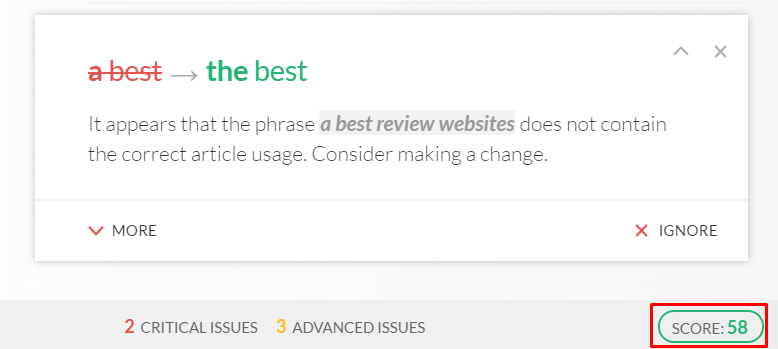 Source: app.grammarly.com
Source: app.grammarly.com
And here is the Acrolinx analog:
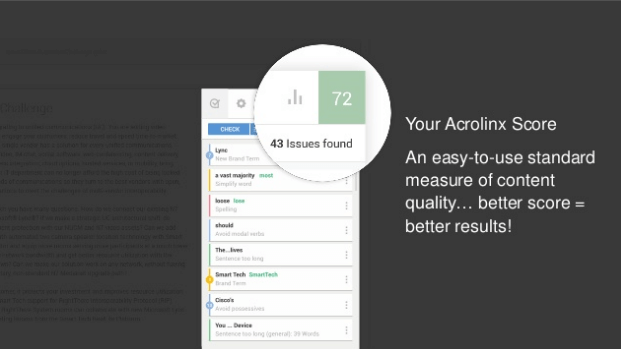 Source: slideshare.com
Source: slideshare.com
Using AI for content optimization is a very effective method for making your content better, more readable and better suited to your target audience.
Andrew Bredenkamp, Founder and CEO at Acrolinx, says,
“While this doesn’t make creating the content any easier, it does help ensure that your content is consistent, aligned with your brand standards, and easier to translate.”
He also adds another interesting thought: with the help of AI, any employee, even one without innate writing skill, can optimize their text and in the end produce high-quality content.
Could Artificial Intelligence Replace Writers and Content Marketers?
People have been wondering for several years whether AI will eliminate the need for human specialists. Many authoritative resources have performed research and made predictions on this, and many experts have written articles about it.
For example, Forrester says that automation will replace 24.7 million U.S. jobs by 2027.
According to the Narrative Science survey, 80% of chief executives think that AI improves worker performance and creates additional jobs, while only 15% believe that AI eliminates them.
As for the content marketing sphere, some forecasts are pretty pessimistic:
- Gartner predicts that by 2018, 20 percent of business content will be created by machines.
- Ray Kurzweil, Google’s director of engineering, forecasts that by 2029 machines will be smarter than humans. In his opinion, robots will be able to joke, flirt and tell full-fledged stories, making human specialists replaceable.
But not everyone shares this view on the future role of AI in content creation.
In 2013 Oxford University analyzed over 700 jobs and calculated the likelihood that AI would be able to completely replace a person.
The first three to become extinct were recreational therapists, laborers, and emergency management directors. Writers were well down the list: 526th of 702 positions.
We can see that the predictions are contradictory. Forecasts remain only forecasts, and only time will show who is right.
Conclusions
If your company’s writers spend a lot of time creating routine texts when they could be doing something more important to bring you more money, you should get acquainted with AI technology.
It allows you to automate the writing process and make it much more efficient.
Here’s what you can learn from our article:
There are some advantages of using AI for content writing. The main one is that AI can quickly produce short and routine texts so that people don’t have to do unnecessary and monotonous work.
AI content creation works as follows. You upload data on an AI platform. The system considers all the options that you set up, interprets the data and includes it into the text.
Modern AI-powered programs can generate the following types of texts:
- Clinical and non-clinical reports
- Sporting and financial news and reports
- Descriptions of different goods and services
- Political speeches
Artificial intelligence cannot yet serve as a full-fledged writer or journalist, write books, or do independent research and write articles based on it. Modern AI is an option only for writing similar and routine short texts.
At the same time, artificial intelligence can pass for a human writer. Most people can’t discern AI-generated text from that written by a human.
Artificial intelligence can help writers even when the writing process is finished. Today there is software that can look through written content and improve it. For example, AI can optimize your writing by making it more relevant and grammatically correct.
There is a chance that artificial intelligence will replace writers and content managers, but some experts say that this is unlikely to happen.
What are your predictions about artificial intelligence in the sphere of content marketing? Do you use this technology in your work? Please, share your opinion in the comment section.